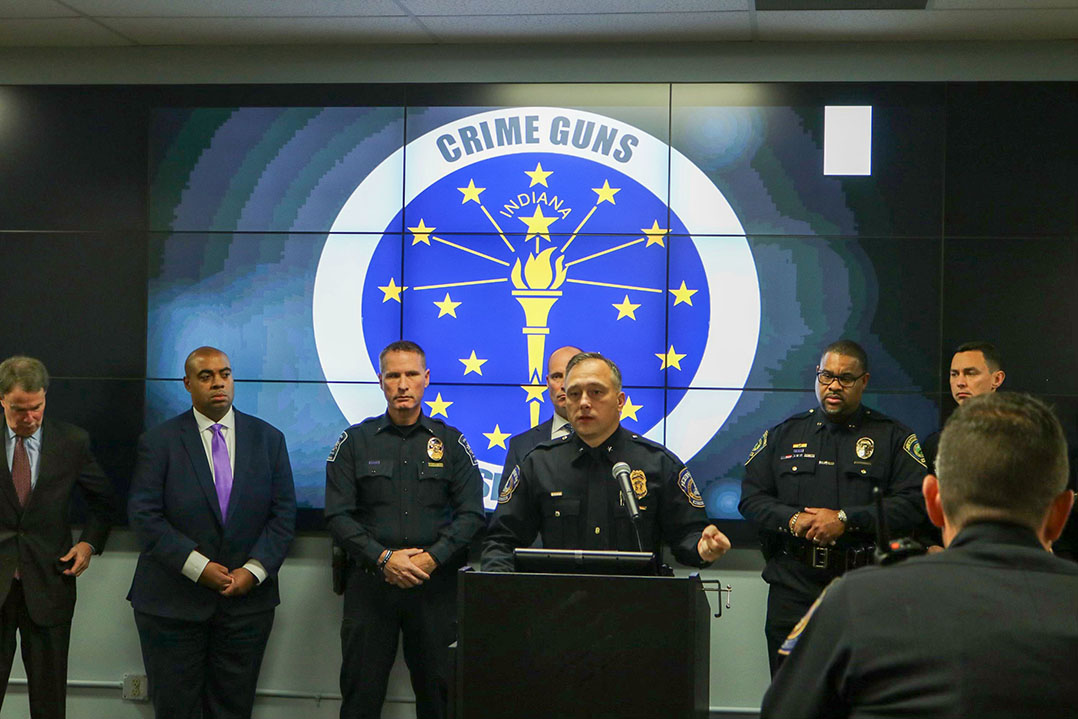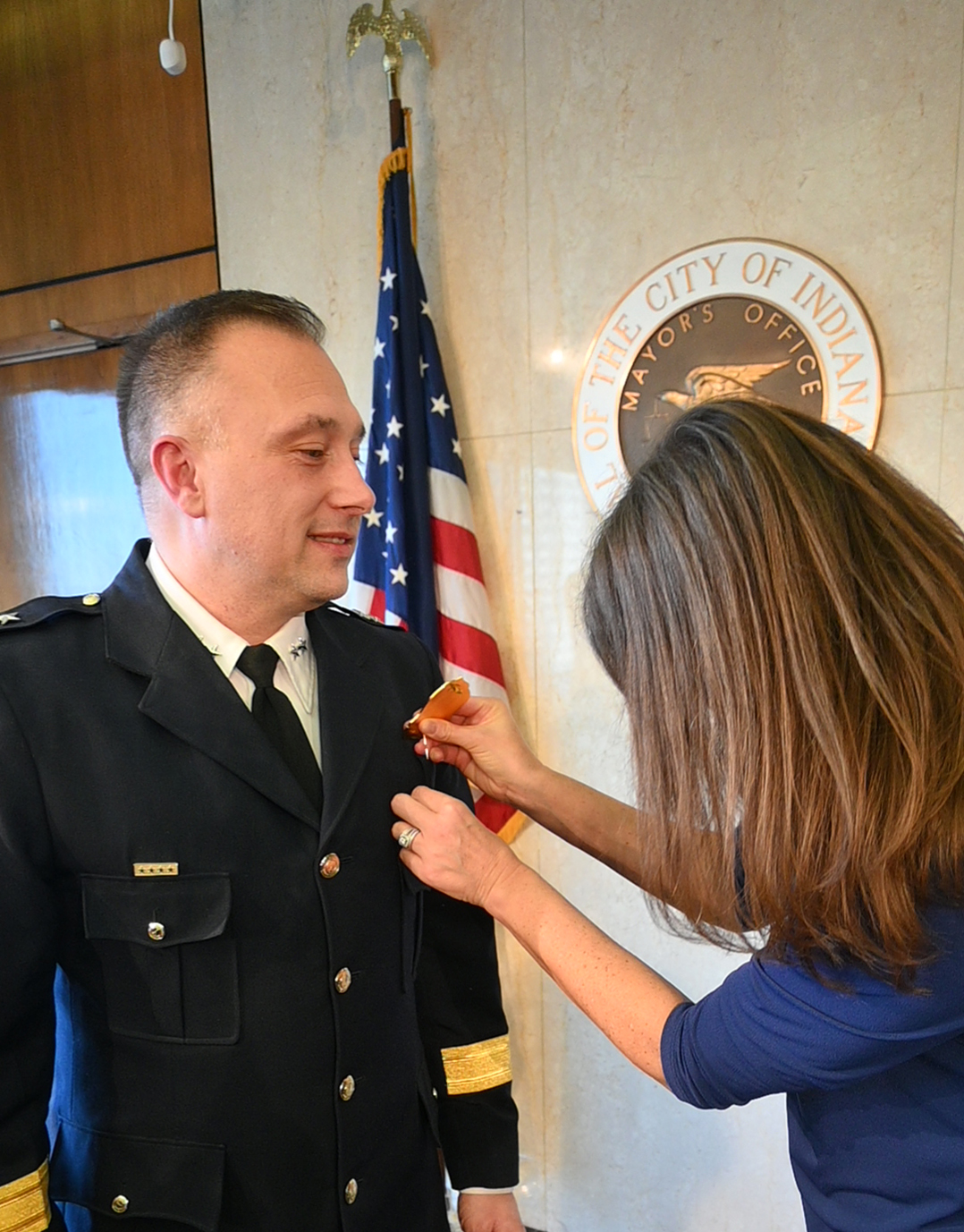Chris Bailey doesn’t remember a time in his life when he didn’t want to be a police officer.
The new Indianapolis Metropolitan Police Department chief started going on ride-alongs with cops he knew from his old neighborhood in Indianapolis’ west end when he was 18. He joined the force in 1999 at the age of 23.
An Indianapolis native, Bailey now leads the largest municipal police department in the state. Formerly serving as chief on an interim basis, he was officially appointed to the position in mid-February by Indianapolis Mayor Joe Hogsett.
Bailey started as a patrol officer in the south district, and said he spent many years there, including a stint as a bicycle officer. He was promoted through the ranks with different responsibilities and assignments along the way.
His favorite assignment was commander of IMPD’s North District.
“That’s really where my heart is,” Bailey said. “That’s been my favorite assignment as an executive on our police department. was leading north district. The great neighborhoods of North District — Butler Tarkington and Crown Hill neighborhoods, and Meridian Kessler and Brightwood, and the Oxford neighborhood and Broad Ripple and Geist — all those neighborhoods, I fell in love with when I was up there. North District, and (Indy’s) north side has a special place in my heart, for sure.”
Part of the district’s appeal is its diversity. he said.
“Both in demographics — the way people look — but also in the types of neighborhoods and there’s diversity in issues. You have some absolute poverty, and you have some absolute wealth, all in the same service district, and talking to all those groups and managing their expectations for law enforcement was a unique experience because they all had unique challenges or unique expectations.”
Bailey said the district managed expectations for those different neighborhoods through multiple community meetings and partnering with residents who wanted to help keep their neighborhoods safe.
“I still hear from people up there — (one resident had) a neighborhood with several hundred houses in it and worked to put together a crime watch group that was so successful that they haven’t had a burglary in the neighborhood in over 10-plus years,” Bailey said. “He still contacts me, and I stay in touch with him and several other people there.”
It’s still early days in Bailey’s tenure as IMPD’s chief, but he is making plans to attract new officers and to make sure the next generation of law enforcement is ready to take the reins. He recently put together his executive team and command staff, which he said is a diverse group, “not only in the way they look but also their vast amounts of experience.
“As we move forward, we have a newer generation of leaders that are taking on the challenge of leading police departments in the 21st century,” he said. “As I step out in a few years, there’ll be leaders prepared to lead the agency into the next 20-25 years of whatever policing holds. I’m proud of the team I put together. It’s about 35 percent African American and 30 percent women — the most diverse command staff in the department’s history.”
Bailey said a police department should reflect the community it serves. That helps recruitment because residents see there are opportunities for people who look like them. Recruitment is essential, he said, with the department down about 300 officer positions.
Bailey said his No. 1 focus is reducing violent crime, and a key component to achieving that is hiring more officers.
He also wants to reduce the number of officer-involved shootings in Indianapolis. Bailey said there were 18 of those shootings in 2023, which is above average.
“Those aren’t all fatal, but they usually average around 10 since (the record of 22 in) 2015,” he said. “So, while it wasn’t a record year, it still causes some concern in our community.”
A new initiative launched in late February is a mental health bureau, which builds on an earlier program that pairs clinicians with officers. The teams respond to calls regarding non-violent incidents and work together to help people experiencing a mental health crisis without resorting to taking those people into custody.
“If we can avoid having the police interact with those people, that’s the goal,” Bailey said. “This new bureau’s responsibility is to try to interact with all those people that are dealing with mental health and try to figure out ways that law enforcement can be better when we respond — or not respond at all and turn that over to someone else, like the clinician-led response team that exists in the downtown district and on the east district 24 hours a day that does not involve a police officer at all. I put somebody in a command level position to help coordinate all those efforts so that we’re all rowing the boat in the same direction.”
Before his appointment to chief, Bailey served as an assistant chief to former IMPD Chief Randal Taylor, who stepped down in late 2023 after four years in the position.

Training brought skills, contacts to IMPD
New Indianapolis Metropolitan Police Department Chief Chris Bailey has had multiple training opportunities inside and outside of Indiana. Those include four weeks of leadership training in the state, 10 weeks at the FBI National Academy, and a three-week training in Florida with PERF — Police Executive Research Forum.
“It’s a think-tank out of Washington, D.C., that’s been engaged in working with law enforcement agencies across the country to find best practices and do studies on how we can do things better and different,” Bailey said. “As part of that class, we had instructors from MIT and Harvard and Boston University.”
Through the various training opportunities, Bailey said he learned skills that he still uses today.
“Even more important than those things are the contacts and relationships that I’ve been able to build up,” he said. “I could pick up the phone and call (someone) in any major city across the country, and even smaller places, to ask a question to find out what they’re doing that’s different than … what we’re doing or ways to make our police department better or even learn from their mistakes.”
Bailey said building relationships is a big part of each of those programs, “so that we can all learn from each other and serve our communities better.”



